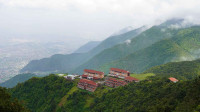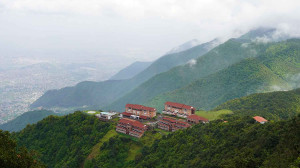Money
Hotel industry prepares for a long recession
It is doubtful when tourists will come back to Nepal despite the vaccination drive, insiders say.
Sangam Prasain
Nepal's hotel industry stuck to its gloomy outlook for the year even as the country launched a Covid-19 vaccination drive on Wednesday, not expecting tourist arrivals to rebound despite the immunisation campaign.
Hotel Association Nepal, which counts around 3,000 establishments among its membership, retained the uniform payout structure, fearing that hotels would not be able to pay their employees as it did not see a tourism recovery this year either.
Under the uniform payout deal made with trade unions, all staff, from front door workers to general managers, will remain on salary without working; but they will all get the same pay. The hotels have also trimmed salaries by 50 percent.
The organisation of hotels and three trade unions renewed their agreement on the uniform payout structure on Tuesday. The pact was initially valid from April 13 to December 31, 2020.
“All three unions representing hotel employees agreed to renew the deal as the scenario of tourists coming back to Nepal is still uncertain,” said Binayak Shah, senior vice-president of the association. “The vaccination drive started on Wednesday, and obviously it raises hopes of a turnaround in the economy; but there are renewed waves of infection and new variants of the virus, casting doubt on tourism prospects.”
According to him, the new agreement is applicable until December 31, 2021. “But if the tourism scenario improves and hotel occupancy increases, the agreement will become invalid.”
As per the renewed agreement, all employees working in five-star hotels or resorts will get Rs5,000 per month. Earlier, it was Rs9,000 per month.
Employees of four-star hotels and resorts will be paid Rs4,000 monthly. Earlier, it was Rs8,000 monthly.
Employees of three- and two-star establishments will receive Rs3,000 and Rs2,500 monthly, respectively. Earlier, they were getting Rs5,000 and Rs4,300 monthly, respectively. Staff of two-star hotels and resorts will get Rs2,000 monthly.
According to the new arrangement, tourist-standard hotels and resorts will get payment based on mutual understanding between the employees and employers.
In light of the Covid-19 pandemic, the hospitality industry continued to be significantly and adversely impacted even after the government lifted the lockdown; and things are unlikely to improve in the next few months, said hotel owners.
The association said in a press statement issued on Wednesday that it was a force majeure situation—the hotels cannot perform the contract due to circumstances beyond their control. Under the agreement, the employees will not get festival or other bonuses and travel allowances.
“As the hotels will not remain totally closed, the employees will be called for duty turn by turn,” the association said. “But the employees called by the management will be paid separately for their work,” the association said, adding that the hotels and resorts would not make new hires, including interns and workers from outsourcing agencies.
Hoteliers said that many hotels in Pokhara and Chitwan had been able to survive due to increased domestic traveller movement; but it's a different story for hotels in Kathmandu as domestic travellers don't dine and stay in tourist establishments here.
The Panel of Tourism Experts of the United Nations World Tourism Organisation has anticipated that the recovery in global tourism will begin in the third quarter of 2021. But roughly one in five panellists believes the recovery won’t start before 2022.
“Most experts do not see a return to pre-pandemic 2019 levels happening before 2023. By regions, the largest share of experts pointing to a return to 2019 levels in 2023 or later are in Europe (74 percent) the Americas (71 percent) and Asia and the Pacific (66 percent). In Africa and the Middle East, this share is 60 percent and 50 percent, respectively,” said the World Tourism Organisation.
The main barrier to an earlier or more rapid recovery is the large-scale travel restrictions that remain in place in many destinations around the world. Alongside that, experts cite slow virus containment and declining consumer confidence as major factors that are hindering the recovery outlook.
Nepal received 230,085 foreign tourists last year, equivalent to the 1986 arrivals figure, according to the statistics of the Department of Immigration.
Most of the visitors came before the country slapped restrictions on tourist entry on March 20. Between April and December, fewer than 15,000 individuals visited Nepal.
On March 12, 2020, the government decided to stop issuing on-arrival tourist visas to nationals of all countries besides cancelling spring mountaineering expeditions including those to Everest.
The decision came a day after the World Health Organisation declared the Covid-19 outbreak a pandemic, and urged countries to take precautionary measures.
From October 17, Nepal opened the door a crack for trekkers and mountaineers, nearly seven months after the country imposed a complete lockdown.
During the lockdown, 91 percent of the hotels and restaurants were completely closed while more than 7 percent remained partially opened, according to a Nepal Rastra Bank study released in August.
An updated study published on January 12 said that after the lockdown was lifted in the third week of July, only 29.70 percent of the hotels and restaurants were in operation fully, while 46.53 percent were operating partially.
Nepal’s manufacturing and service sector reported the highest 50.51 percent recovery in production or turnover after the lockdown was lifted. Hotels and restaurants were at the bottom of the list with an 18.11 percent recovery in their business transactions.




 13.98°C Kathmandu
13.98°C Kathmandu















